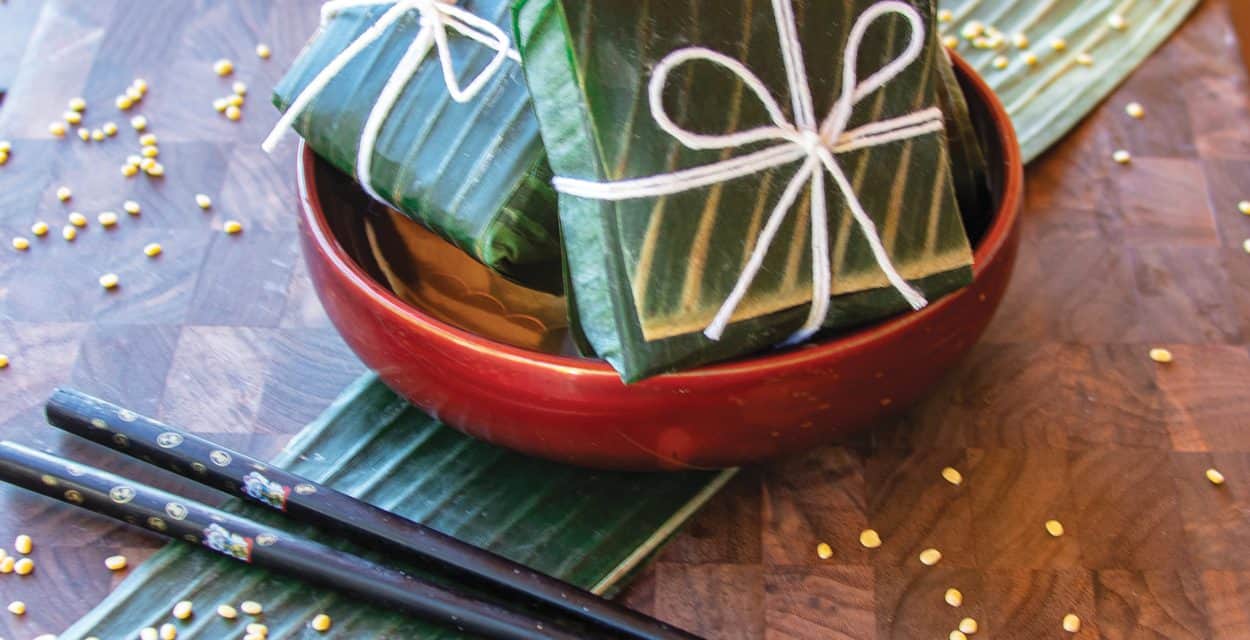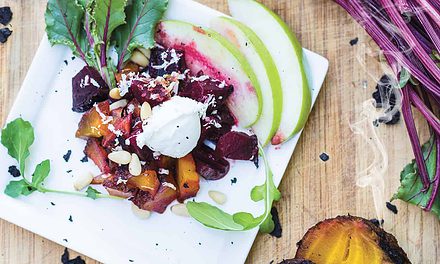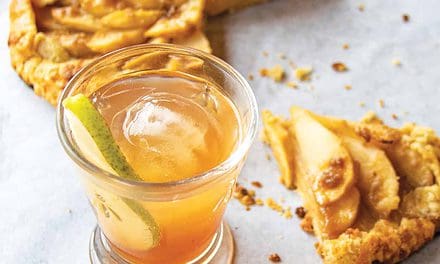By Hue-Chan Karels

The Importance of Bánh Chưng to the Vietnamese People
Bánh chưng or chưng cake is a traditional Vietnamese rice cake made from simple local ingredients such as glutinous rice, mung beans, and pork, wrapped in banana leaves and boiled or steamed. It is an irreplaceable, must-have food item to celebrate Tết Nguyên Đán, the Vietnamese Lunar New Year (known simply as “Tết”), which means “Feast of the First Morning of the First Day of Spring.” Banh chưng is served with pickled onions or vegetables and savory fish, pork, or beef. The making and eating of bánh chưng during Tết is a well-preserved tradition of the Vietnamese people.
Legend attributes the creation of bánh chưng to Lang Liêu, a prince of the Sixth Hùng Dynasty over three and a half millennia ago. It was said that in choosing a successor, the monarch decided to carry out a competition in which each of his sons would bring a delicacy paying homage to the ancestors on the occasion of the Tết holiday. Whoever could introduce the most delicious dish for the altar would become the country’s next ruler. While other princes tried to find rare and delicious foods from the forest and sea, the eighteenth prince, Lang Liêu, who was the poorest son of the Hùng king, could not afford such luxurious dishes and had to be content with everyday ingredients, such as rice and pork. From these simple ingredients, he created one cake in the square form of earth, called bánh chưng, and one in the round form of sky called gánh giầy. In tasting the dishes offered by his son, the Hùng king found bánh chưng and bánh giầy not only delicious but also a fine representation of the respect for ancestors. Therefore, he decided to cede the throne to Lang Liêu and proclaimed bánh chưng and bánh giầy traditional foods during Tết.
The Making of Bánh Chưng—A Labor of Love and Tradition
Making bánh chưng reflects the essence of slow food and requires the contribution of several people. The main ingredients are glutinous rice, pork meat, and mung beans, which are wrapped together in banana leaves that give the rice a green color after boiling. The glutinous rice must be soaked in water overnight, then assembled with the other ingredients, wrapped in square shapes, and boiled for many hours over a wood fire. The process of making and eating banh chưng is an opportunity for family and friends to come together during Tết. Here, I am providing an adaptation of the traditional recipe, mainly adjusting the size of the cakes. Traditionally, these cakes are 8-inch squares each weighing 3 to 4 pounds! These smaller cakes can be easily made and cooked by steaming rather than boiling.
Bánh Chưng (Rice Cake)
Ingredients
- 2 cups dried split mung beans, washed and soaked in water 4 hours or overnight
- 5 1/2 cups glutinous or sweet rice, “sticky rice”, washed and soaked in water 4 hours or overnight
- 1 pound pork butt/shoulder or belly or combination, cut into 1/2-inch slices
- 1/3 cup shallots, minced
- 3 cloves of garlic, minced
- 1 1/2 tablespoons Vietnamese fish sauce, adjust to taste
- 2 teaspoons ground black pepper, adjust to taste
- 2 1/2 tablespoons salt, adjust to taste
- 3 tablespoons vegetable oil
- 1 pound fresh or frozen banana leaves, defrosted
- Kitchen twine
Instructions
- Place mung beans in a pot filled with just enough water to cover. Bring to a boil over medium heat, then reduce to a simmer and cook, occasionally stirring, until very tender, about 30–45 minutes. Drain, then put in a food processor with 1 1/2 tablespoons salt and 1 1/2 tablespoons vegetable oil; pulse until beans are mashed and all ingredients are well combined. Set aside.
- Drain and season the soaked sticky rice with 1 tablespoon salt.
- Season the pork with fish sauce, 2 teaspoons pepper,
- garlic and shallots; marinate in the refrigerator for 3 hours or overnight.
- Heat remaining oil in a frying pan over moderate heat. Add pork pieces and all the marinade; stir just until the meat is brown around the edges, about 3 to 4 minutes. Remove pan from heat and set aside.
- To reduce cooking time, use a 3-inch x 3-inch mold. For a traditional, family-size cake, use a 6-inch x 6-inch mold.
- To start, soften the banana leaves by wilting in single layers in a 200°F oven for 5-10 minutes. Then, cut and line the molds with 2 to 3 pieces of banana leaves, making sure that the edges are padded to avoid any spillage or leakage. The dark side of the leaves should face inside the mold (this will tint the rice a light green color), leaving enough banana leaf to cover the cake.
- Make 1/3- to 1/2-inch layer of sticky rice, spreading it up the sides of the mold. Add about 2 tablespoons of mung bean paste, spreading it to cover the sticky rice layer. Add another 1/3- to 1/2-inch layer of sticky rice to the sides, then place a layer of pork and another layer of mung bean paste. Make sure all the sides are covered with sticky rice. Lay the final layer of sticky rice on top and press everything down tightly.
- Bringing all the sides of the banana leaves together, remove the entire mixture from mold and wrap. Then coat the entire cake with another piece of banana leaf, the dark and shiny side on the outside. Tie with twine, loosely enough to allow the rice to expand, but not too tightly.
- In a steamer, steam on low to medium heat for 2 hours (for 3-inch x 3-inch cakes). Turn the cakes half-way through and check the water in the steamer. Remove from heat, and set aside to cool for 1 hour.
- To serve, cut the cake diagonally from corner to corner (without unwrapping). Once cut, remove wrapping and arrange slices on a serving plate. Serve warm or at room temperature. If wrapped in plastic and refrigerated, the cake will keep up to 1 week.
About Hue-Chan Karels
Hue-Chan Karels is chef-owner of Open Kitchen, a unique culinary concept that celebrates the kitchen as the center of sensory pleasure, healthy living, community, learning, and creativity. Hue-Chan’s passion for the culinary arts is only surpassed by her desire to bring people together through shared food experiences. She loves to share her knowledge and recipes and to foster enjoyment for cooking and creating healthy, delicious meals at home.
Launched in 2009, Open Kitchen’s multipurpose space was hailed as one of the best new eateries in the Washington, DC metro area, featuring a farm-to-table bistro, private event space, cooking school, and commercial kitchen
rental facility. In 2014, Hue-Chan and her husband brought Open Kitchen to Santa Fe. Today, Open Kitchen has been reimagined to offer inspired culinary events and services including interactive dining experiences, creative food and drink pairing events, hands-on specialty cooking experiences, retreats, and a healthy chef-prepared meal delivery service.
Born in Da Nang, the largest city in central Vietnam, Hue-Chan and her family settled in the United States in 1975 as refugees in the aftermath of the Vietnam war. She endeavors to deepen understanding of Vietnam’s unique cultural identity, beliefs, and histories as she shares recipes and stories that bring Vietnamese food to life.
Edible celebrates New Mexico's food culture, season by season. We believe that knowing where our food comes from is a powerful thing. With our high-quality, aesthetically pleasing and informative publication, we inspire readers to support and celebrate the growers, producers, chefs, beverage and food artisans, and other food professionals in our community.













